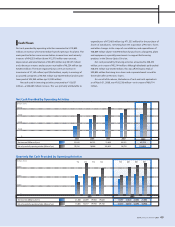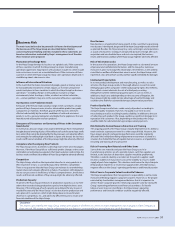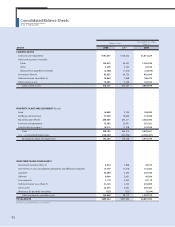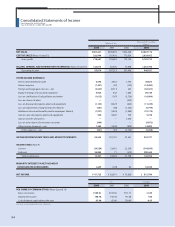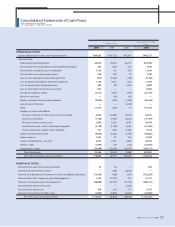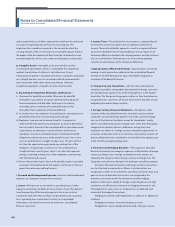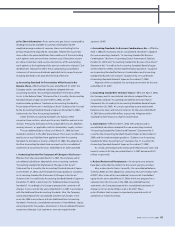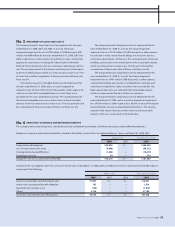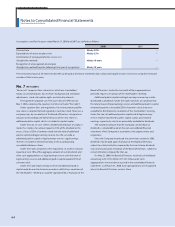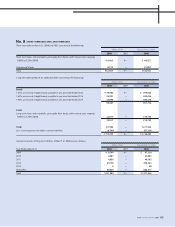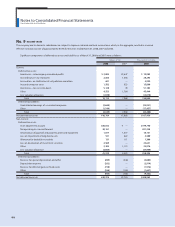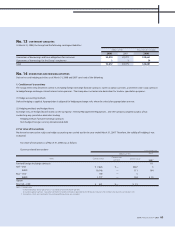Pentax 2008 Annual Report Download - page 61
Download and view the complete annual report
Please find page 61 of the 2008 Pentax annual report below. You can navigate through the pages in the report by either clicking on the pages listed below, or by using the keyword search tool below to find specific information within the annual report.
Notes to Consolidated Financial Statements
Hoya Corporation and Subsidiaries
No. 1 BASIS OF PRESENTING CONSOLIDATED
FINANCIAL STATEMENTS
The accompanying consolidated financial statements have been
prepared in accordance with the provisions set forth in the Japanese
Financial Instruments and Exchange Act and its related accounting
regulations, and in conformity with accounting principles generally
accepted in Japan, “Japanese GAAP”, which are different in certain
respects as to application and disclosure requirements of International
Financial Reporting Standards.
The accounts of overseas subsidiaries are based on their
accounting records maintained in conformity with generally accepted
accounting principles prevailing in the respective countries of domicile.
The accompanying consolidated financial statements have been
restructured and translated into English (with some expanded
descriptions and the inclusion of consolidated statements of changes
in net assets for 2006) from the consolidated financial statements of
Hoya Corporation (the “Company”) prepared in accordance with
Japanese GAAP and filed with the appropriate Local Finance Bureau of
the Ministry of Finance as required by the Japanese Financial
Instruments and Exchange Act. Some supplementary information
included in the statutory Japanese language consolidated financial
statements, but not required for fair presentation, is not presented in
the accompanying consolidated financial statements.
The translations of the Japanese yen amounts into U.S. dollars are
included solely for the convenience of readers outside Japan, using the
prevailing exchange rate at March 31, 2008, which was ¥100.19 to U.S.
$1. The convenience translations should not be construed as
representations that the Japanese yen amounts have been, could have
been, or could in the future be, converted into U.S. dollars at this or any
other rate of exchange.
No. 2 SUMMARY OF SIGNIFICANT ACCOUNTING
AND REPORTING POLICIES
a. Principles of Consolidation—The consolidated financial statements
as of March 31, 2008 include the accounts of the Company and its 100
(67 in 2007 and 62 in 2006) subsidiaries (together, the “Group”). Under
the control or influence concept, those companies in which the
Company, directly or indirectly, is able to exercise control over
operations are fully consolidated, and those companies over which the
Group has the ability to exercise significant influence are accounted for
by the equity method.
Investment in an affiliated company through the years is
accounted for by the equity method and remaining non-consolidated
subsidiaries and affiliated companies are stated at cost due to
immateriality.
All significant intercompany balances and transactions have been
eliminated in consolidation. All material unrealized profits included in
assets resulting from transactions within the Group are eliminated.
b. Cash Equivalents—Cash equivalents are short-term investments
that are readily convertible into cash, and are exposed to insignificant
risk of changes in value. Cash equivalents mature or become due
within three months of the date of acquisition.
c. Inventories—Inventories are stated principally at cost using the
average method.
d. Investment Securities—All investment securities are classified as
available-for-sale securities. Marketable available-for-sale securities are
reported at fair value, with unrealized gains and losses, net of
applicable taxes, reported in a separate component of net assets. The
cost of securities sold is determined based on the moving-average
method.
Non-marketable available-for-sale securities are stated at cost
determined by the moving-average method. For other than temporary
declines in fair value, investment securities are reduced to net
realizable value by a charge to income.
e. Property, Plant and Equipment—Property, plant and equipment
are stated at cost. Depreciation of property, plant and equipment of
the Company and its domestic subsidiaries is computed substantially
by the declining-balance method at rates based on the estimated
useful lives of the assets, while the straight-line method is applied to
buildings acquired on or after April 1, 1998 by the Company and its
domestic subsidiaries, and to almost all property, plant and equipment
of consolidated foreign subsidiaries. The ranges of useful lives are from
10 to 50 years for buildings and structures and from 3 to 12 years for
machinery and vehicles.
In accordance with the revision of the Corporation Tax Law,
starting in the consolidated fiscal year under review, a depreciation
method based on the revised Corporation Tax Law is used for tangible
fixed assets acquired on or after April 1, 2007. The change caused
operating income and income before taxes and other items to decrease
¥426 million ($4,252 thousand). The effect of this change on business
and geographical segments was insignificant.
This revision of the Corporation Tax Law also affects the treatment
of assets acquired on and prior to March 31, 2007. The residual
amounts of these assets shall be depreciated to the memorandum
values (¥1) in a straight line over five years, commencing with the
following fiscal year in which each asset's depreciation reaches to 5% of
the acquisition cost by the declining method defined in the old
Corporation Tax Law is terminated. The effects of this change on
income before taxes and minority interests were insignificant.
f. Impairment of Long-Lived Assets—The Group reviews its
long-lived assets for impairment whenever events or changes in
circumstance indicate the carrying amount of an asset or asset group
may not be recoverable. An impairment loss would be recognized if the
carrying amount of an asset or asset group exceeds the sum of the
HOYA ANNUAL REPORT 2008 59


